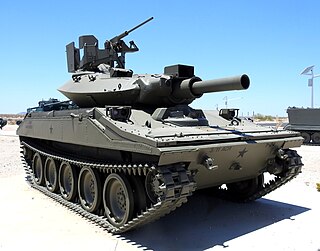
The M551 "Sheridan" AR/AAV was a light tank developed by the United States and named after General Philip Sheridan, of American Civil War fame. It was designed to be landed by parachute and to swim across rivers. It was armed with the technically advanced but troublesome M81/M81 Modified/M81E1 152 mm gun/launcher, which fired both conventional ammunition and the MGM-51 Shillelagh guided anti-tank missile.

The Bradley Fighting Vehicle (BFV) is an American tracked armored fighting vehicle of the United States developed by FMC Corporation and now manufactured by BAE Systems Land & Armaments, formerly United Defense. It is named for U.S. General Omar Bradley.

The M113 is a fully tracked armored personnel carrier (APC) that was developed and produced by the FMC Corporation. The M113 was sent to United States Army Europe in 1961 to replace the mechanized infantry's M59 APCs. The M113 was first used in combat in April 1962 after the United States provided the South Vietnamese army (ARVN) with heavy weaponry such as the M113, under the Military Assistance Command, Vietnam (MACV) program. Eventually, the M113 was the most widely used armored vehicle of the U.S. Army in the Vietnam War and was used to break through heavy thickets in the midst of the jungle to attack and overrun enemy positions. It was largely known as an "APC" or an "ACAV" by the allied forces.

The 105 mm howitzer motor carriage M7 was an American self-propelled artillery vehicle produced during World War II. It was given the service name 105 mm self propelled, Priest by the British Army, due to the pulpit-like machine gun ring, and following on from the Bishop and the contemporary Deacon self-propelled guns.

The FV101 Scorpion is a British armoured reconnaissance vehicle and light tank. It was the lead vehicle and the fire support type in the Combat Vehicle Reconnaissance (Tracked), CVR(T), family of seven armoured vehicles. Manufactured by Alvis, it was introduced into service with the British Army in 1973 and was withdrawn in 1994. More than 3,000 were produced and used as a reconnaissance vehicle or a light tank.
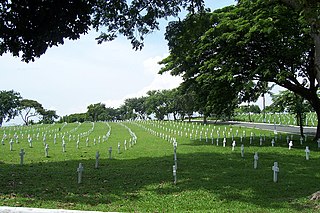
Libingan ng mga Bayani is a national cemetery within Fort Bonifacio in Barangay Western Bicutan, Taguig, Philippines.

The LAV III is the third generation of the Light Armoured Vehicle (LAV) family of armored personnel carriers built by General Dynamics Land Systems – Canada (GDLS-C), a London, Ontario, based subsidiary of General Dynamics. It first entered service in 1999, succeeding the LAV II. It is the primary mechanized infantry vehicle of both the Canadian Army and the New Zealand Army. It also forms the basis of the Stryker vehicle used by the U.S. Army and other operators. The Canadian Army is upgrading its LAV IIIs to the LAV 6 standard. Early in its development history it was referred to as the 'Kodiak', but the name was never officially adopted.

The Cadillac Gage Commando, frequently denoted as the M706 in U.S. military service, is an American armored car designed to be amphibious. It was engineered by Cadillac Gage specifically for the United States Military Police Corps during the Vietnam War as an armed convoy escort vehicle. The Commando was one of the first vehicles to combine the traditionally separate roles of an armored personnel carrier and a conventional armored car, much like the Soviet BTR-40. Its notable height, amphibious capability, and waterproofed engine allowed American crews to fight effectively in the jungles of Vietnam by observing their opponents over thick vegetation and fording the country's deep rivers.
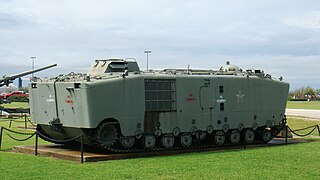
The LVTP-5 is a family of amphibious armored fighting vehicles used by the Philippine Marine Corps, the Republic of China Marine Corps, and, formerly, the United States Marine Corps. It was designed by the BorgWarner company and built by FMC along with a few other companies. It was first accepted into service in 1956. Some 1,124 basic units were produced, plus the specialist variants, and many saw action in the Vietnam War.
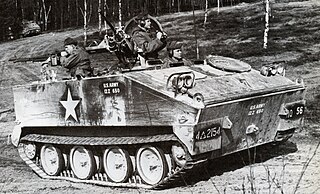
The M114 Command and Reconnaissance Carrier is a Vietnam War-era tracked armored fighting vehicle, used by the United States Army. It was manufactured by the Cadillac Division of General Motors in the early 1960s. The M114 was designed to be fast and stealthy for use in the reconnaissance role.

The AIFV is an American tracked light armored vehicle that serves as an infantry fighting vehicle (IFV) in the armies of several countries. It is a development of the M113A1 armored personnel carrier.
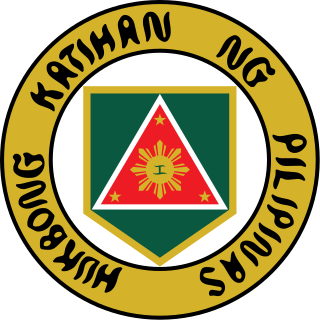
The Philippine Army (PA) is the main, oldest and largest branch of the Armed Forces of the Philippines (AFP), responsible for ground warfare and as of 2021 had an estimated strength of 143,100 soldiers The service branch was established on December 21, 1935, as the Philippine Commonwealth Army. The Philippine Army has engaged in many conflicts including the ongoing Communist rebellion in the Philippines, the Moro conflict and, alongside other national military forces, in conflicts of international scope.
A huge number of M113 armored personnel carrier variants have been created, ranging from infantry carriers to nuclear missile carriers. The M113 armored personnel carrier has become one of the most prolific armored vehicles of the second half of the 20th century, and continues to serve with armies around the world in many roles.

The Simba is a wheeled armoured personnel carrier designed by GKN Sankey. It is currently in service with the Philippine Army.

The Bravia Chaimite is an armoured vehicle with all wheel drive axles built by the Portuguese company Bravia and used by the Portuguese Army in the Portuguese colonial wars in Angola, Mozambique and Portuguese Guinea, from 1967 to 1974 when it ended. The Chaimite was originally an unlicensed derivative of the Cadillac Gage Commando assembled and later produced in Portugal, with a number of improvements and technical modifications.

The Presidential Security Command, (PSC) formerly known as Presidential Security Group (PSG), is a Philippine close protection agency. It is the primary agency concerned with providing close-in security and escort to the President of the Philippines, their immediate families, former presidents of the Philippines as well as visiting heads of state.

An armoured personnel carrier (APC) is a broad type of armoured military vehicle designed to transport personnel and equipment in combat zones. Since World War I, APCs have become a very common piece of military equipment around the world.

The Cavalry Brigade "Pozzuolo del Friuli" is a brigade of the Italian Army, based in the Friuli-Venezia Giulia and Veneto regions. The Brigade consists of a command unit, a cavalry regiment, an amphibious infantry regiment, an artillery regiment, an engineer regiment and a logistic regiment.
The 1910 Fort Bonifacio War Memorial Tunnel is a tunnel that was part of Fort William McKinley, a military base built by the US Military Government of the Philippines in 1902. The tunnel alignment is now part of Taguig's Bonifacio Global City district and the Embo barangays, and is considered a historical site by the Bases Conversion Development Authority (BCDA). The main roads near it are C-5 and Kalayaan Avenue.

The Armor "Pambato" Division was formerly known as the Mechanized Infantry Division before it was renamed in anticipation of its upcoming assets and ongoing reorganization of units of the Philippine Army as part of the modernization program. It is stationed at Camp O'Donnell, Brgy. Sta. Lucia, Capas, Tarlac and is one of the service's major units. The Armor Division is a combined arms organization composed of tank, cavalry and mechanized infantry.































